Water is an incredibly precious resource, essential for life, and it is no wonder that so many preppers spend so much time accumulating it and storing it in advance of a major disaster.
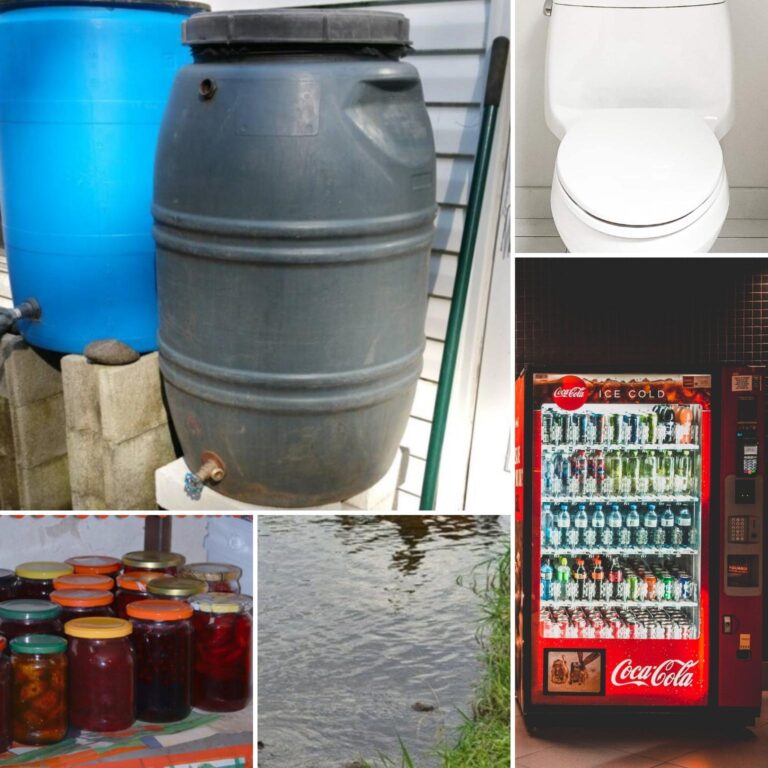
You have at most only a few days to live without anything to drink and dehydration is a bad way to go, so this is one area where you can’t afford to get it wrong.
But drinking from a contaminated water source in your haste could prove just as costly, poisoning you or making you ill from a variety of contaminants.
Reliable access to safe drinking water is mandatory for survival. Storing water is one thing but what do you do when that water runs out or is otherwise lost?
Where will the next drink come from to slake your thirst and that of your family? Having multiple, redundant plans in this regard could make the difference between life and death.
Abundance is the name of the game when it comes to water and you don’t want your survival hanging in the balance of a single source that may or may not provide for the duration.
In the interest of bulletproofing your family survival water plan, we will share with you 12 emergency water sources that you can call upon in a variety of disaster scenarios in order to provide safe drinking water for your family.
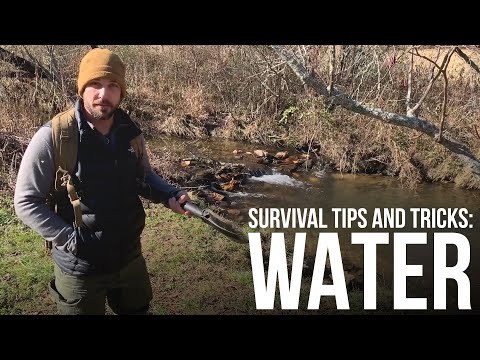
Always Assess Your Water Sources
Before we get to the water sources on our list, I must remind you that you cannot take anything for granted in a survival situation.
Any given water source you’ll find, from the seemingly pristine natural stream or spring to a crystal clear pool could potentially be harboring contaminants that could make you or someone you love gravely ill.
First and foremost, the notion of the immaculately pure natural water source is mostly a myth for practical purposes, as there are all sorts of natural contaminants that are bad news, not the least of which being animal droppings, carcasses, and various microscopic organisms.
That refreshing spring might be contaminated by equally all-natural heavy metals locked deep in the earth, the two brought together by tectonic action, leaching, or permeation.
Man-made contaminants abound also in the form of fuel and chemical spills, biological dumping, and good old-fashioned trash.
I tell you all this to impress upon you the necessity of weighing your need for water against your survival timetable and available resources for purifying that water.
If time permits you should always filter and then boil or chemically treat your water to remove as many contaminants as possible before drinking it or using it for cooking.
On that note, it is also imperative that you understand the precise capabilities and limitations of any purification system you employ, of any kind.
If you assume your water filter will remove viruses, but it doesn’t, you could be in for a nasty wake-up call.
Also, you should understand the likelihood of additional contamination risk based on the type of disaster or situation you are dealing with.
An earthquake imparts an extreme risk of contamination for most man-made emergency water sources but a variable or moderate risk to natural water sources.
On the other hand, floods are a massive contamination risk for virtually every water source!
Take the time to think through the context of what has occurred and how that might have affected the water source you are about to draw from.
In short always take steps to improve the quality of any water source you collect from if you are able, and if this proves impossible drink from the water source most likely to have remained uncontaminated or the least contaminated. With that said, let’s get on to the list!
12 Emergency Water Sources to Quench Your Family’s Thirst

Lake / Pond
Freshwater lakes and ponds are often one of the first sources of emergency water that people think of so long as they know of one nearby.
Although certainly dependable and unlikely to dry up in any but the lengthiest drought conditions your average lake or pond is rarely going to be a clean, pure source of water.
Pond water in particular is notorious for being murky, scummy, and absolutely swarming with microscopic life.
Lake water is rarely any better but if you have the capability of getting farther out on the lake before drawing it you stand a better chance of reducing the amount of contamination at least somewhat.
Take care when drawing water from any lake or pond that it has not been contaminated by human dumping, chemical spills or other mishaps.
Consider filtration and other purification steps mandatory, and you should only drink directly from either only in times of uttermost need.
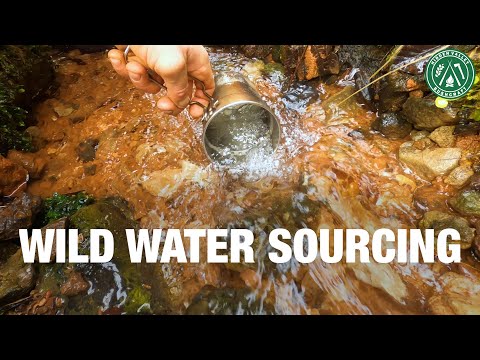
Streams / Rivers
Streams are another popular natural water source and ones you should prioritize over the average freshwater pond or lake.
Though streams and rivers are inherently just as vulnerable to all sorts of contamination, including the same types that ponds and lakes are, you have a slight advantage in that they are running water, not stagnant water, and therefore less likely to turn into some hideous biological soup.
Do take care of that any source of contamination upstream will contaminate water down the stream of it, even if the water appears clean and fresh.
When drawing from a stream you would be wise to patrol the banks for a distance in either direction checking for obvious and severe contaminants.
You definitely don’t want to be drawing water downstream from a rotting moose or deer carcass!
Once you are reasonably satisfied that there are no obvious contaminants drawn from it freely, you should again take care to filter and purify the water if at all possible.

Rainwater
When you are in a jam and desperate to replenish your water supplies, a good, hard rain is a boon from heaven.
I hate to rain on your parade, pardon the pun, but even rainwater might not be as pure as you are thinking, especially over major urban areas with high atmospheric contamination.
Even so, it is dependably going to be a far sight cleaner than anything else we are able to collect out of ground-bound sources.
The trick to capitalizing on a passing shower is being in a position to collect as much as possible as efficiently and as safely as you can. Luckily you’ll have several options for accomplishing this.
Before you do anything, consider what the rainwater has contacted before you collected it.
Rainwater that has hit the ground and runs along a gutter is not likely to be any cleaner than any other source of water, yuck.
Rainwater that has only pattered off of your roof before being caught in a bucket will be significantly better, and rainwater that has been caught directly in a clean and sterilized container will be best.
Regarding the collecting part, if you have any advance notice you might do well to set up a large, wide-area collection system made from tarps, plastic sheeting, and clean PVC piping or guttering that can direct swathes of water into a large central cistern.
Lacking this time or other materials you might do well to place larger containers beneath downspouts or under the eaves of roofs that will catch large amounts of rainwater quickly.
Lacking even this you can fall back on the old reliable method of simply placing as many clean containers over as large an area as possible while it is raining.
A natural drinking water resource like this is invaluable during a survival situation, so don’t neglect it!

Vegetation Transpiration
No, that is not the name of some experimental psychedelic rock album!
As it turns out plants release moisture similar to the way that you and I do when we breathe out and it is possible to capture a meager (but possibly life-saving!) amount of water when this process occurs.
All you need to do is locate a leafy plant that receives direct sun, the leafier the better, and cover it with an impermeable plastic membrane to which you will attach some small vessel for collecting the drops of water that form on the inner layer.
Before you begin, take pains to verify that your chosen plant is not toxic or in any way contact-harmful as the likelihood that you’ll contaminate your water source is just too high.
You definitely want to avoid drinking water that has formed off of poison ivy or something like that.
This process is best initiated in the early hours of the morning before the heat of the day has truly set in, but you should expect to leave it to work for most of the day.
You might have to fiddle with a plastic a little bit to form runnels through which the water will travel before dropping into your container.
A large shrub might only produce a mouthful or two of water but this might make the difference in a dire emergency.
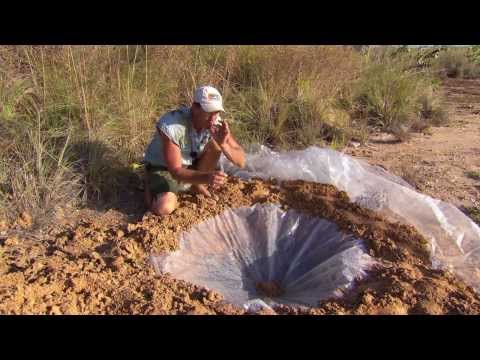
Solar Still
A solar still functions on a similar principle to the one we employed for the previous method for harvesting moisture from plant transpiration.
By digging a shallow pit in the ground and securing a sheet of plastic over it we can rely on rising moisture facilitated by the sun’s rays to condense on the plastic sheet or we can then direct it into a container.
This method is somewhat easier and more reliable than the previous one so long as the ground is easily dug and the sunlight is abundant.
Finesse matters here. Any plastic sheet that you choose must be water and permeable and large enough to completely cover whatever pit or scraping you have dug.
The edges should be sealed down tightly using rocks, loose soil, or anything else that is available but don’t do that just yet.
In the center of your scraping, you should place the container that you’ll use for catching and holding what water you are able to harvest.
Once this is in place with the plastic over it take a small pebble or rock, something just heavy enough to form a depression in the plastic and place it directly over the container atop the plastic.
Any beads of condensation that form will be directed by gravity to this depression where they will fall into your container once they grow heavy enough.
Once again, this is a marginal method of water collection but what water you do collect will be quite pure and safe to drink.
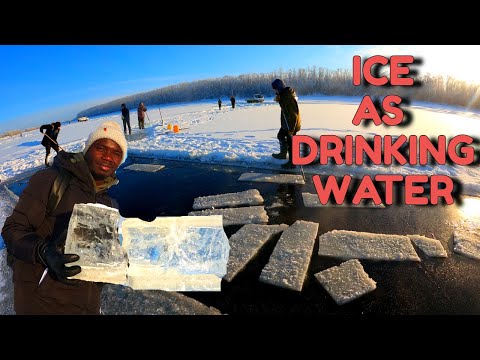
Ice
Depending on your situation and the environment ice might be a great option for sourcing clean drinking water in an emergency.
Ice has an advantage in then it can be accessed in a man-made context- from your freezer, from corner store ice chests, and elsewhere- or in a natural context, like icicles or frozen precipitation off of your car or other surfaces.
In some environments or seasons, ice could be a plentiful and reliable source of drinking water all on its own.
How you collect and deal with the ice varies from source to source, but the one thing they have in common is that you have to warm the ice up one way or another before you’ll have water to drink.
For man-made sources of ice, you can be reasonably sure that they’ll be safe to drink as-is once you melt them.
Ice that comes out of your freezer or ice machine will have been produced essentially from tap water, and hopefully filtered by your refrigerator before being turned into ice cubes.
Similarly bagged ice you can get from any corner store or grocery is likely purified prior to being frozen.
However, natural sources of ice demand a little more care in selection. Where did the water that formed the ice come from prior to freezing into a sheet, icicle or whatever?
We have all seen the nasty, black piles of snow that line freshly plowed city streets and parking lots: is that something you would melt and drink as is?
Consider filtering and further purifying any naturally sourced ice prior to drinking it.

Pool / Hot Tub
One of the largest and most accessible reserves of reasonably clean water available to many people is going to be a nearby pool or hot tub, whether it is theirs or someone else’s.
The advantage of drawing drinking water from a pool or hot tub is that you will typically have many hundreds or even thousands of gallons at your disposal.
The bad news is that, depending on the state of maintenance and frequency of use of the pool, the water could be significantly contaminated with common chemicals or other biological matter from users.
Obviously a pool or hot tub that has been badly neglected and left to go green and stagnant will be scarcely better than pond water.
Assuming the pool water is clear and smells of chlorine, it is far more likely to be safe than many natural sources- although ingesting chlorinated water should be done very sparingly to avoid negative effects.
At any rate, pool or hot tub water can be filtered to further improve taste and safety, and don’t forget the chlorine breaks down over time with exposure to air, so you can draw water from a pool, leave it to sit, and wait for typical chemicals to break down.
Even if you don’t have a pool of your own nearby gyms and health clubs might, and this could prove to be one of the best sources of water early on for urban survivors.
Water Heater
When the power is out, the gas is shut off or the flow of water into your home is otherwise disrupted there is no reason why you should not access the large reserve of water on standby at any given time inside your hot water heater tank.
Many typical residential models hold tens of gallons and this can make for an excellent supply of clean water so long as you know how to access it.
In fact, it is such a reliable and controllable reserve of water that some preppers advocate shutting off water coming into the house ASAP after the onset of a disaster with the hope of preventing contamination from reaching the water heater’s supply.
You don’t need to destroy your water heater to access the water inside, but you will have to follow proper procedure and know what you are doing to get to it reliably and in a controlled fashion.
Your first step is to stop the heating of the water, typically done by turning the controls to the “off” or “low” position and then disconnecting electricity or natural gas.
Once the heater elements are cool or the pilot light and burner have gone out, then all you need to do is open the relief valve located near the top of the tank before opening the spigot near the bottom.
Make sure you have some common garden hose handy to connect to the spigot so that you can reliably direct the water into whatever container is suitable, as a spigot is often very low to the floor.
You don’t want to waste the water inside and you also don’t want to be dealing with a flood!

Toilet Cistern
Don’t spit your drink out; I’m referring to the tank of the toilet, not the bowl where you do your business!
Though the notion of drinking any water out of a toilet is probably going to give some people the heebie-jeebies, I must remind you that the water going into the tank is nominally clean and uncontaminated by any biological matter related to urine or feces.
This tank usually contains quite a bit of water that is ready to access if not immediately ready to drink.
There are still a couple of major culprits regarding contamination of water in your toilet’s tank, with mold or mildew being one and rust being the other in case you have an older flush kit in there.
Also, it should go without saying, if you use any in-tank cleansers or toilet maintenance additives like bleach tablets or those weird blue wafer things you cannot drink the water from the tank! Now as always, if in doubt filter the water first if you can.
Water Trapped in Pipes
In two-story homes or multi-level buildings, there is often water left trapped in the pipes once the flow of water has been cut off or pressure dropped too low to force it out of taps.
As you might expect this water is certainly drinkable but getting to it can prove very challenging unless you know this one simple trick.
All you need to do is open as many taps as possible on the upper floor of the house, or the highest floors of a multi-level building before going to the lowest taps on the lowest accessible floor and preparing to draw water.
By opening the upper taps you allow gas into the system which will then let the water flow out of lower taps.
Note that it is not unusual for a small trickle of water to come out of the higher taps when you open them, but there will be much more waiting for you at the lower ones, so be prepared to capture it!
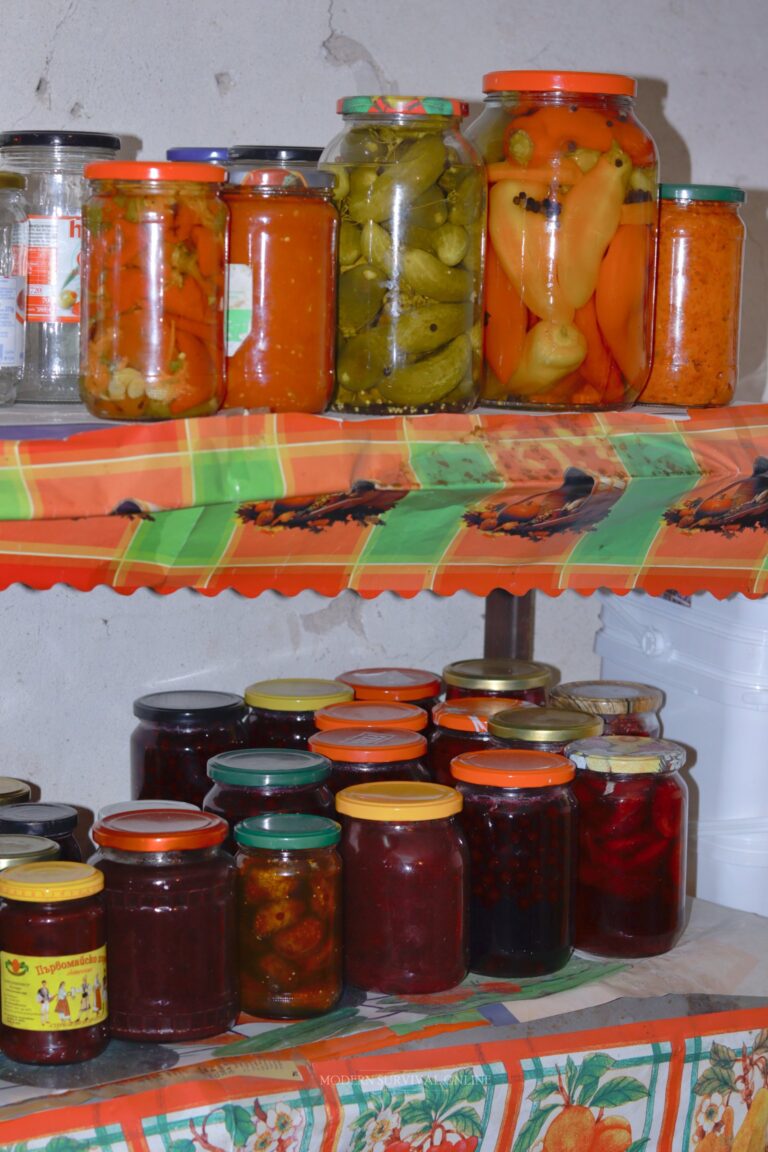
Canned Fruit and Veggies
This is one of those “why didn’t I think of that?!” sources of drinkable liquid, if not water per se, but we are including it under a technicality since some fruits and veggies are packed in water.
Bust open your pantry and look for any “wet” canned goods that have high moisture content. Fruits and veggies are your first and best options but don’t discount things like tuna, either.
Though the notion of sipping on some salty, vaguely briny tuna or green bean water when you are desperately thirsty might not be the most appealing choice in the world, it sure beats dehydration. Do keep in mind that the salt or sugar content might need to be accounted for.
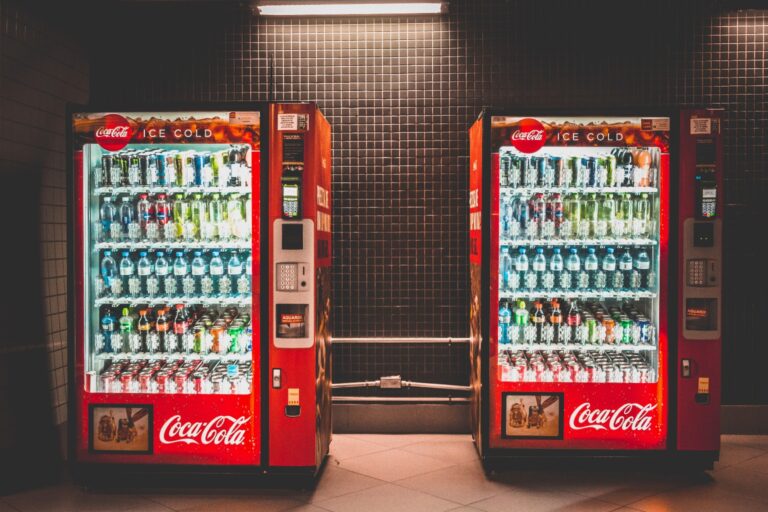
Vending Machines
It is easy to forget isolated sources of bottled water or other beverages in a crisis.
When store shelves have been made barren by legions of panicked shoppers or just wiped out, literally, by the disaster in question you can probably have a little luck if you find an intact or overturned vending machine.
Assuming the machine is still powered, simply insert your coinage and take your beverage but if not, you’ll find they are not difficult to break into meaningfully using any sturdy prying tool.
I’m not advocating for hooliganism but survival is paramount, and when the chips are down you’ll have to do what you need to get the resources required.
Conclusion
Running out of water will put anyone in dire straits during a survival situation no matter what else is happening or what environment you are in.
Every prepper should have multiple, redundant ways to source water including man-made and natural options. Only by being prepared to capitalize quickly on alternate water sources can you stave off dehydration and death.
Review the sources presented in this article, commit them to memory, and make sure your plans can facilitate making use of them.
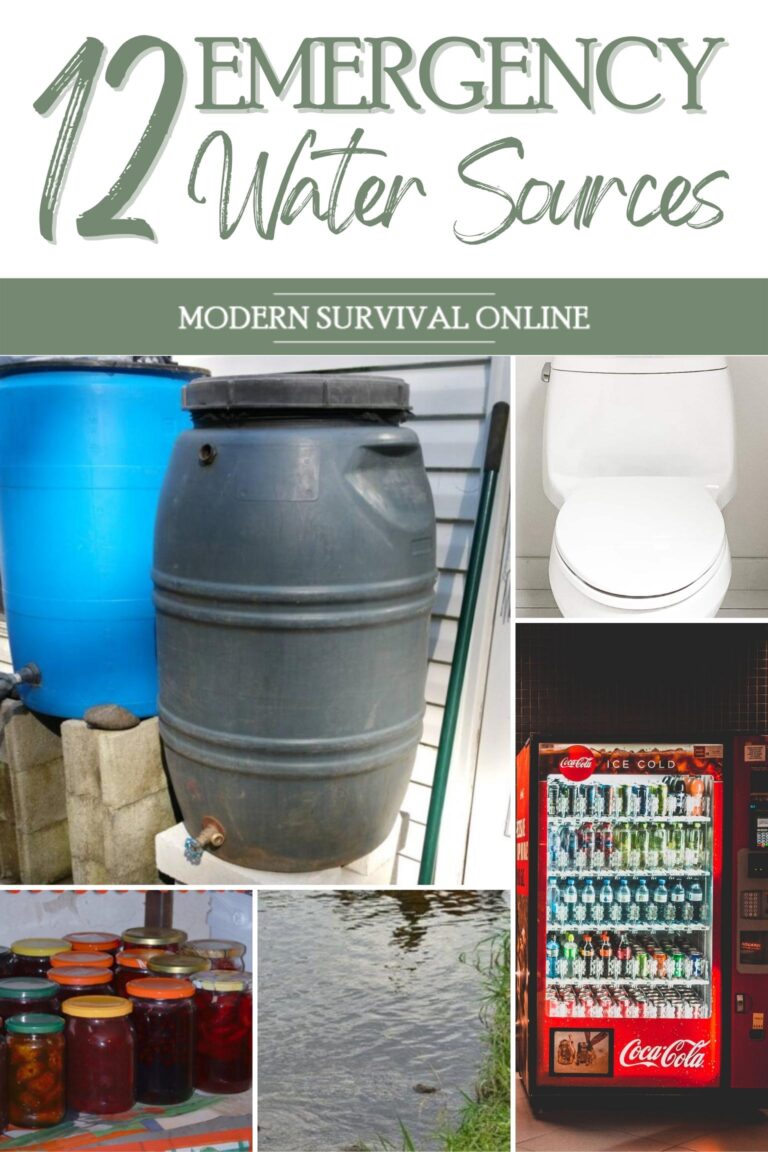
via Modern Survival Online https://ift.tt/7L5QNCU
No comments:
Post a Comment